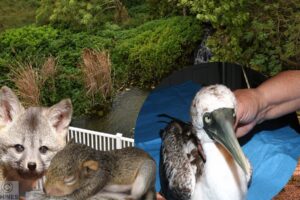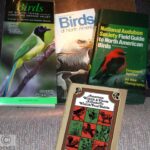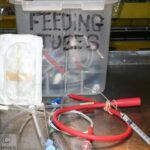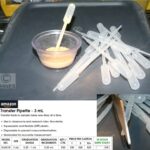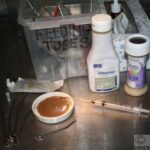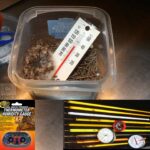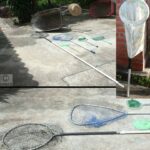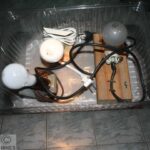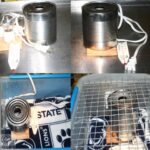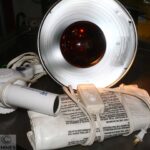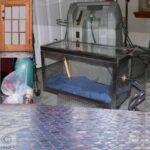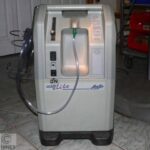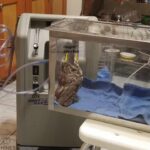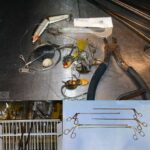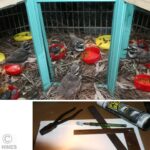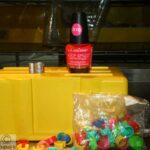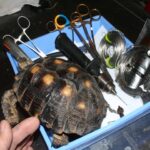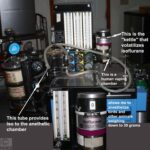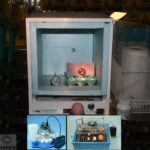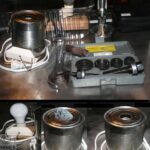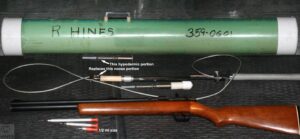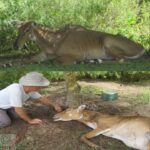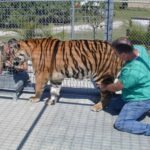A Wildlife Rehabilitator’s Guide To Basic And Specialized Supplies
Ron Hines DVM PhD
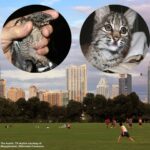 All Of Dr. Hines’ Other Wildlife Rehab Articles
All Of Dr. Hines’ Other Wildlife Rehab Articles
Buying Some Good Books That Identify The Animals That People Bring You, What They Eat And How They Live Their Lives In The Wild
People with warm hearts for animals are not always informed about what arrives at their doorstep or what they spot along the roadside. When they reach me, shrews like the ones in the header photo come in as “mice”. Nighthawks are usually dropped off as baby owls. Blackbirds are dropped off as crows. Tortoises as turtles – and vice versa. I live in deep tropical Texas along the Mexican/Texas border. So, caracaras often come in as bald eagles. Coots are usually presented to me as duck. Exotic pet shop Russian tortoises and young sulcatas come to me as endangered Texas tortoises. Not long ago, an Eastern box turtle arrived. How it managed to cross the Mississippi River and end up in Brownsville I will never know. So unless you are a learned biologist, buy some wildlife identification books like the ones in the ones in the photo. Even then, I have had birds arrive, grow up or recover and be released where I was never sure what their precise species was.
I mentioned that I live in a unique portion of the United States – the Texas Rio Grande Valley. More than a third of Mexico lies north of me. Our climate is tropical, rains are unpredictable and thorny brushland and tropical species prevail. You will notice that my articles are weighted toward birds. That is because approximately 85% of the animals presented to me are birds. Perhaps that will not be so where you live. The rehab residents are also weighted toward water and shorebirds. That is because I am on the coast. In the fall and spring, species that do not nest here arrive in large numbers because we are the first point of land these birds encounter on their north-south migrations up and down the Central North American flyway. The rest are year-round tropical species that you will never see. For instance, our blue jays are green. 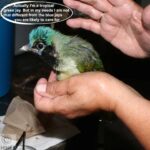 So, I have books that identify the birds of Mexico as far south as Costa Rica as well as those of the United States. At one time, before Google Images and Wikipedia existed, I relied on Bernhard’s 17-volume Animal Life Encyclopedia. No one knew more about the Animal Kingdom than Dr. Grzimek, one of my heroes.
So, I have books that identify the birds of Mexico as far south as Costa Rica as well as those of the United States. At one time, before Google Images and Wikipedia existed, I relied on Bernhard’s 17-volume Animal Life Encyclopedia. No one knew more about the Animal Kingdom than Dr. Grzimek, one of my heroes. 
Mammals only represent 11% of my admissions. I would gladly take in more; but most end up at our local zoo. Those that do come to me are primarily opossums, cottontail rabbits, turtles, tortoises, bats and non-native fox squirrels released here by wintering Midwesterners. Our local beaver, cougar, bear and almost all of our two native parrot species were hunted to extinction shortly after the 1848 war with Mexico when the human population of this area became significant. The old battlefield parks are still one of my favorite release areas.
Customize Your Supplies To Your Clientele And Plans
No one can be good at everything and days continue to be 24 hours long. I suggest you begin by becoming good at raising and caring for no more than one or two species. Word spreads fast and in most parts of the United States there are far too few wildlife rehabilitators. It is so easy to become overextended. Know your limits. How many squirrels or cottontails can you care for at one time before the quality of their care begins to decline? How much of your time will you have to devote to fund-raising rather than animal care as resident numbers grow? How many of your personal relationships will have to be put on hold as your free time disappears?
Here Are Some Of The Things That I Have Found Useful:
Feeding Droppers And Tubes
Foundlings will always make up the greater portion of your admissions. In some parts of the United States the majority will be small mammals. In others (like mine) it will be birds. They will require a variety of tubes, catheters, syringes and blunted needles to feed them properly. You may not know that it costs your local hospital considerable money to dispose of expired and cast off supplies. The FDA requires that most consumable supplies that they purchase have an expiration date of less than two years. Expiration date is only vaguely related to shelf life. Is an unopened bottle of sterile salt solution any different after its 2-year expiration date? How about hypodermic needles or disposable stitch scissors? Whatever the FDA’s rational, eventually near-expiration and expired supplies end up back in the hospital’s purchasing department. There the director must make a decision if the items are hazardous waste. If he/she decides no, the stuff goes in the dumpster. But to avoid fines and lawsuits it is always safer for that person to decide yes and pay to have a specialty hazardous waste company collect them. In Texas, unannounced State inspections fine hospitals when they find out-of-dated items still on departmental shelves. Monthly departmental inventories to spot them before the inspectors do require a lot of staff time costing them money. So many of the supplies on the discard pallets are just short-dated. Over the years, hospitals have always been happy when I picked up these supplies. Because of liability issues, they prefer not to donate the items to human charities. My agreement has always been that I take everything on the pallet – no picking out just the stuff I need and making a mess. It also helps to always bring presents for the hospital receiving staff – arrive at 10 bringing them lunch.
Temperature Control
The smaller an animal is, the more important body temperature control becomes. That is particularly true of songbirds and mammals that weigh under 100 grams. Nature gave those animals high body temperatures throughout their lives; which translates into a high metabolic rates and the need for abundant calories to sustain it. Infant animals have practically no calorie and nutrient reserves to fall back on. Instead, they rely on your providing frequent small feedings of protein and calorie-rich diets to sustain their rapid metabolism and growth. Also, when their body temperature drops to sub-normal, they cannot absorb nutrients from their digestive tract even when you supply them. Pooling of nutrients in their intestines results in bloat, even lower body temperature, acidosis and death. Even older animals, particularly birds, are also subject to rapid health decline when not offer supplemental temperature support. That is because Nature designed them to be lightweight to give them the ability to fly. Most birds can’t store calories as fat as most mammals do. A degree or two one way or the other may not seem like much to us on a warm or chilly day, but it can be a life or death matter for the animals in your care. That is why I have so many thermometers.
Small birds and mammals naturally run hot. The exception are bats and opossums. I took a pause from writing this to step into one of my aviary recovery room a few minutes ago. The cloacal (“rectal”) temperature of an obliging 58 gram South Texas nighthawk (pauraque) was 104 F/40 C. A 20 gram South Texas flycatcher (kingbird) about a week before release, had a cloacal or “core” temperature of 108.4 F/ 42.4 C. But that does not mean that you should keep these birds in a 104-108 F environment. Those temperatures are core body temperatures – temperatures deep within their bodies – not on their surface or in their cloaca. I keep the young birds surface temperatures at about 36 C/ 98 F usually using low-watt light bulbs as heat sources. If you keep birds much warmer than that you can injure them or stunt their growth. To read more about the difference between skin temperature and core temperature in birds ask me for McCafferty2015 & Larcombe2007.
I try to maintain small immature mammals in an environment of 85 F/ about 29.5 C. If they feel just a bit warm to your touch, that is about right. At the right temperature, youngsters should have good muscle tone, they should be alert and will hopefully vocalize and squirm about when stimulated. If not, their temperature probably needs to be cautiously raised with a heat source or lowered if they feel hot, breath rapidly or are excessively pink. The safest, but most inconvenient way is using a hot water bottle. Particularly in summertime, you also need to access them for dehydration. I give modest amounts of warmed, electrolyte balanced, subcutaneous fluids when these individuals have just come in and need rehydration. Multiple small amounts, stop and observe and repeat if necessary is usually the best plan. You can read more about that here. I give them no food by mouth or tube until their body temperature and hydration have improved. The same goes for adult animals of all species. None digest or absorb nutrients or fluid normally from their intestines well when they are chilled (hypothermic) or significantly dehydrated. That’s another reason why, over the years, I have accumulated so many thermometers.
Nets
I am always on the lookout for fish net frames. For birds and small mammals the original fish netting needs to be replaced with a cloth sac. Struggling birds get hopelessly tangled in fish net netting. Because they can see you, wild animals become terrified when restrained in mesh nets. That causes them major stress, broken legs, broken wings, eye scrapes, muscle damage (capture myopathy), and requires that the netting be cut and destroyed in order to remove the animal safely. I find that pillowcases, such as the one in the photo, are good netting replacements. For larger muscular animals like raccoons, bobcats and otters, canvas mail sacks, and deep canvas tote and boat bags work well as replacements for the original netting. Mature otters detest restraint of any kind. I have had healthy otters die when confined to a pet carrier overnight to protect them from unseasonably cold weather. The butterfly nets and small-mesh aquarium net in the photo work well to catch small bird escapees indoors.
Pillowcases and canvas nets won’t do when you are attempting to retrieve an animal from a lake or bog. For those situations, I attached a 10-foot stick of 3/4 inch Schedule 40 PVC pipe to the handle as you see in the photo. If you cap the distal end of the pipe the net will float. When farther out from the shore, I just paddle out in my small jon boat to retrieve them.
The first of these two images is of bulbs and homemade bases I use for various purposes. My primary use these days is to attract night-active insects for my nightjars as I transition them over to more natural diets in outdoor flights. I have still not decided if “grow lights” attract more flying bugs than ordinary incandescent bulbs.
The second image is how I use the same items as a surrogate warming “Mom”. I make them from 20-ounce tin cans placed over a 15 or 20 watt light bulb. The Home Depot sells what you will need to make one. If you wrap the can in a soft material – be sure it is something non-flammable that does not give off toxic fumes or melt. I personally don’t wrap the cans in anything (the hole in the can top in the photo is because it doubles as my egg candler). That image comes from my article on raising orphan raccoons. I try to slowly bring the body temperatures of raccoon kits up to 100 F/37.8 C before I attempt to give them anything by mouth.
Other Heat & Light Sources
I have heating pads and infra-red ceramic cones that can also provide warmth. However over the years, I have seen as many animals hurt by those two devices as helped by them. I much prefer hot water bottles and low-watt bulbs as seen in the paragraph above because they are much safer for the animals. Human blow driers are OK – if you keep your hand directly in the airflow to monitor the temperature directly surrounding the animal. If I use a blow-drier, it is because the animal came in very chilled and near death. Even then, the animal is always in my hand when the blow-dryer is on. Blow driers designed specifically for safe use with animals deliver air at lower temperature but higher volume. Those are the ones you see in dog grooming shops hanging on cages. Human hair driers deliver much hotter air at a much lower total airflow; so you must use them on animals very cautiously.
Scales
Accurate scales and carefully monitored food intake are the two most accurate ways to monitor animal health. That is because a lack of normal weight increase in youngsters or decreasing weight in adult wildlife are usually the first signs of health and management issues. You can see the normal growth progress of many North American birds here, opossums here. Many more are online. Accurate scales used to be quite expensive. They no longer are. You can buy them on eBay for a pittance. But being a perfectionist, I keep a set of known weights and check my scales for accuracy now and then. I put them beside the three scales that I own when I took the photo above. If you operate on a shoestring, you can just fill various size tight sealing bottles with sand, pebbles, BBs, etc. and then weigh and mark them at the deli section of your local supermarket. Scales used in commerce are monitored by your state and must meet NTEP guidelines. Avoid scales that say “not legal for trade”. The sock in the photo was from a pair my wife found too gaudy. Animals are not going to sit still when you attempt to weigh them. So, it is convenient to place them gently in containers like socks with little wiggle room. You can pre-weigh the socks and mark their weight on the fabric as I do or just weight them empty first and press the tare weight button. When one of your residents poops in the sock, the sock goes to the trash.
Did you know that many birds weight slightly more than their parents at the time they leave their nest? That gives them an edge on survival as they learn to fend for themselves. That is why I hand feed most of my animal wards a bit longer that their natural parents would. I hope that makes up for some of the negatives of human/animal contact that always occurs in a wildlife rehabilitation situation.
Oxygen
Any bird that is rhythmically open-mouth breathing needs oxygen. If it is a bird, and it is still able to stand, its tail will be bobbing up and down as well. The same need for oxygen goes for mammals that are open-mouth breathing or dyspneic. There is no guaranty that they will recover – more than half that come to you in that condition won’t. But those that don’t receive oxygen will rarely recover on their own. When I accepted native wildlife at my San Antonio animal hospital, I had three Large oxygen tanks bolted to the outer building wall. The red blotch you barely see in the plastic bag near the tank on the left is a scarlet tanager that came in gasping and on its side after a window collision. I would place birds in a clear bag like the one you see there and blow the bag up with oxygen like a birthday party balloon. That gave them a “padded cell” Birds in particular tended to thrash around during recovery. This seems like a good time to tell you that a bag, filled with oxygen like that on is, is highly explosive if a spark or flame gets near it and that doing what I did most likely violated numerous laws. Another fact: in San Antonio, Texas at that time, both welding grade and hospital/medical grade oxygen were filled from the same bulk tank at the AOC/Praxair oxygen supply company. I know because I went there to fill them.
The gray portable oxygen generator and the aquarium-like oxygen chamber to the left are what I use now. The chamber measures 21″ long, 12″ high and 9 3/4″ wide. It is held together with GE Advanced Silicone Kitchen & Bath Sealant™. Again, I want to emphasize that when you work with oxygen, things that normally don’t burn or just smolder, can become fireballs when exposed to concentrated oxygen. I recall one veterinarian dying when she accompanied a horse into a hyperbaric chamber to keep it calm. The horse’s thrashing horseshoes sparked and the chamber, padded with furniture-mover blankets, exploded.
Instruments And Forceps To Remove Swallowed And Tangled Items
Living on the coast in Texas and Florida, a lot of seabirds (mostly pelicans and herons) come to me tangled in fishing line, lures, hooks and netting. In the photo above, I put some of the stuff I have removed from them over the years on the table along with an image of the medical retrievers I used to remove some of them. Regarding fishhooks: you will do much less damage to the animal if you push the hook barb in a downward or sideways arc rather than attempt to move it backwards the way it entered. Once the barb is visible, snip it off with wire snips and then back out the hook. If the hook barb’s metal is too hard for the snips, it will snap off below the barb when bent sideways or back. Pelicans cruising fishing wharves and channels are such gluttons. They are my prime beachfront patients. Once removed, I have never seen an entry/exit wounds become infected. Birds have remarkable resistance to infection. Pelicans also come to me that have swallowed the fisherman’s plastic baggie of bait along with its contents of shrimp, squid or mullet. They are usually retrievable if you insert your arm down the bird’s throat. Their esophagus is amazingly expandable.The other common hang up is a pelican who attempted to swallow all or a portion of a filleted fish skeleton – tail first rather than head first. I also own a borescope and retrievers that allow me to view the contents of an animal’s stomach, grab things that shouldn’t be there and back them out. Borescopes designed for medical use are called gastroscopes. Colonoscopes work just as well going down the throat and I find that those used for sinus surgery or to peer into the lungs are great for smaller critters. I have used various scopes to peer into the stomach of dolphins, large snakes, sea turtles, walrus and penguins in order to fish out non-food items that they had swallowed. My finds have included infant pacifiers, designer tote bags and baggies, ear rings, dimes nickles and quarters, eyeglass frames, slivers of fiberglass and chunks of urethane foam. It is a constant problem in Zoos – boredom makes for strange appetites.
A Mirror Box
All animals imprint on what they see early in life in determining who and what they are and who their friends and enemies should be. Precocious chicks like chickens and ducks are said to imprint the strongest between ~12 and 36 hours of hatching, geese between ~12 and 17 hours. Altricial chicks probably do so as soon as their eyes are open enough to track you. Whether scent plays a part in their recognition of their species remains unknown. By the time they are two weeks old, wolves have a sense of self based on who nourishes them – that is despite their eyes not opening until their 11th to 15th day. So sound and/or smell play a part in their recognition of who they are. Until about their 10th day, rodents appear to identify their mothers by scent alone.
Those are some of the reasons I am not enthusiastic about the effectiveness of hand puppets. I prefer introducing animals, when no sibling exists, to mirrors. The particular three-mirror box in the photo above spans 11.25 x 11.75 inches. I built it for a killdeer that came in on its hatching day – still pipping from inside its egg. You can read more about that here. As the bird matured, I moved it to the mirror box cage and dropped various live food items within its reach. Two weeks later, a second killdeer unexpectedly arrived. That one had already imprinted well on its killdeer mother so I placed them together. But during its initial 14 days alone the first one became shyer and shyer of me. Whether that was due to some inborn killdeer genetics or if the mirrors played a part I cannot say. Animals have an instinctive fear of things that approach from above – such as your hand or a hawk. That is why I place all of my cages of recovering birds well above eye-level and keep plenty of hiding places available for mammals.
When it comes to imprinting on foods, there is no information regarding whether wildlife food preferences are based on what you feed your rehab animals or if the animal’s genes play a part in determining the foods they will seek out after you release them. In us humans, our genes are thought to only play a small part in our food and taste preferences. (read here) You can partially deal with that by wisely choosing what you feed and how that food is presented. How soon in an animal’s life that needs to be begun is unknown.
More Specialized Equipment
Leg Bands And Identifiers
I am not a fan of leg bands. Over the years I have had to remove leg bands that were applied too tight or too loose. The band on the left of the photo is one I removed from a Swainson’s hawk. The bird came in emaciated due to poor hunting success. It died. The hawk had been removed from its nest several months previously and banded in a high school science project. The band was exceedingly tight. Pelicans come to me with the same problem. It angers me because there is little to no useful scientific data gathered from banding birds that pass through wildlife rehabilitation centers. If you search through the NCBI index, you will find that no useful information was ever gathered through banding programs at wildlife rehabilitation centers since the NCBI went digital in 1962. When I want to keep track of a specific animal, I put a small dab of hot pink children’s nail polish on the tip of an ear or tail feather. It wears off after a month.
Animal abuse is a particular sore point for me. Texas Parks & Wildlife once tricked me into rehabilitating a wild parrot with a broken wing until it could fly again. Then, without informing me, they strapped a battery pack to its shoulders, placed two antennas on its head and tracked its flight in the Rio Grande Valley until it died of starvation.
Turtle And Tortoise Repair Supplies
You will get a lot of satisfaction repairing these creatures for release. It is worthwhile to learn how to do it properly. You can read about the tools required and the techniques that I use here.
An Anesthesia Chamber
My oxygen chamber doubles as my anesthetic chamber. My compound of choice in inhaled anesthetics is isoflurane gas. Animals do regain consciousness faster when sevoflurane is used, but isoflurane is more economical. Neither is flammable. To the best of my knowledge, isoflurane is also the most common gas rehabilitators use for euthanasia. None of these gases are healthy for you to repeatedly inhale. I modified the Drager human anesthesia machine (“gas buggy”) in the second photo by substituting a human vaping chamber for animals that weigh under 200 grams. However, for most of the surgery I do today, I rely on injectable ketamine. Ketamine anesthesia has the disadvantage of taking much longer to wear off. Also, if you inject too much ketamine in a single injection, the consequences are irreversible. However, ketamine allows me to continue to do complex surgeries in the absence of the trained veterinary nurses that I once employed.
I want you to be cautious when working with all gas anesthetics and chemicals. There are strict OSHA rules to minimize your exposure to those gases because they have the potential to damage your liver and permanently harm you in many other ways.(read here)Never work with these anesthetics or other volatile chemicals other than out-of-doors, upwind on a breezy day, or in a room with a gas scrubber. Even then, exercise sufficient caution and common sense to prevent your inhalation of these gases. My photos are taken indoors to display them in good photographic light – not as in use. Because I have done things I write about is no reason that you should.
An Incubator
Throughout my career with wildlife I have never been without an incubator. At one point I incubated exotic bird eggs from day one in my Marsh/Lyon Turn-X or Marsh Roll-X incubators like the ones you see at the bottom of the photo. They have precise temperature and humidity control and a motor that eliminated the need for frequent turning of the eggs by hand. But somewhere in my career I lent them out. I no longer recall when or where – but like many things lent out, they were never returned. At one point I had an Airshield pediatric incubator as well. But now I just use a converted hospital towel warmer that I fitted with a new thermostat and internal fan. It works well for wild bird eggs that have begun to pip and as a home for newly hatched or rain-soaked chicks until they dry off. Occasionally, I will place an infant squirrel or cottontail in it as well while I’m preparing their longer-term quarters.
An Egg Candler
You can purchase one on Amazon for $54.99. However, I have always made mine out of old tin cans. People will bring you eggs. With experience using a candler, you will be able to guess how close they are to hatching and if they are still alive. Dead eggs explode in incubators.
More Serious Capture Equipment
These days I rely on the pole syringe you see in the middle of the first photo to restrain and transport hoof stock, bobcats and the like to my home for care. But there was a time I used the Pneu-dart™ 50 caliber CO2 rife with percussion cap syringes you see in the photo as well. Depending on the species, I filled those syringes with xylazine or increased-concentration ketamine. When the dose is correct, the animals can still walk and be peacefully led. I never liked that rifle. It causes too much tissue damage at the point of impact. My current pole syringe is more humane. But even more humane, when possible, are herding techniques – improvise some form of boma funnel trap based on the resources at hand and what the situation demands. I did that frequently to herd flamingos from one place to another using opaque crowd control barriers.
You are on the Vetspace animal health website
Visiting the products that you see displayed on this website help pay the cost of keeping these articles on the Internet.

